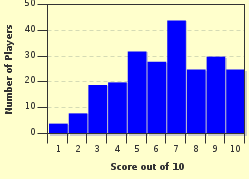Quiz Answer Key and Fun Facts
1. In 1964 "Have I the Right" by the Honeycombs reached Number Five on the US charts. What was unique about this British-Invasion era band?
2. Which of these bands was actually a British group?
3. The Caravelles was one of the first British acts to have a significant Top Ten hit in America. What was the title of their 1963 US Number Three single?
4. Manfred Mann was born Manfred Sepse Lubowitz and went on to form Manfred Mann. The group emerged as a prominent British Invasion group in 1964 when they released "Do Wah Diddy Diddy". What country was Manfred born in?
5. Wayne Fontana was a vocalist with Wayne Fontana and the Mindbenders. He was actually born Glyn Ellis but took his stage name from drummer D. J. Fontana. Which legendary artist did D. J. Fontana play for?
6. Which group DID NOT derive inspiration for the band's name from a movie?
7. Which band did not actually exist when their US Number One single in 1966 was released?
8. Which group, known for their zany dance routines, included a diagram by dance instructor Arthur Murray depicting their dance steps as part of a 1965 album?
9. In 1964 what was the first British Invasion-era non-instrumental song to reach the Number One slot in the US?
10. Which British Invasion group was banned from performing in the US by The American Federation of Musicians for four years beginning in mid-1965?
Source: Author
shanteyman
This quiz was reviewed by FunTrivia editor
kyleisalive before going online.
Any errors found in FunTrivia content are routinely corrected through our feedback system.

